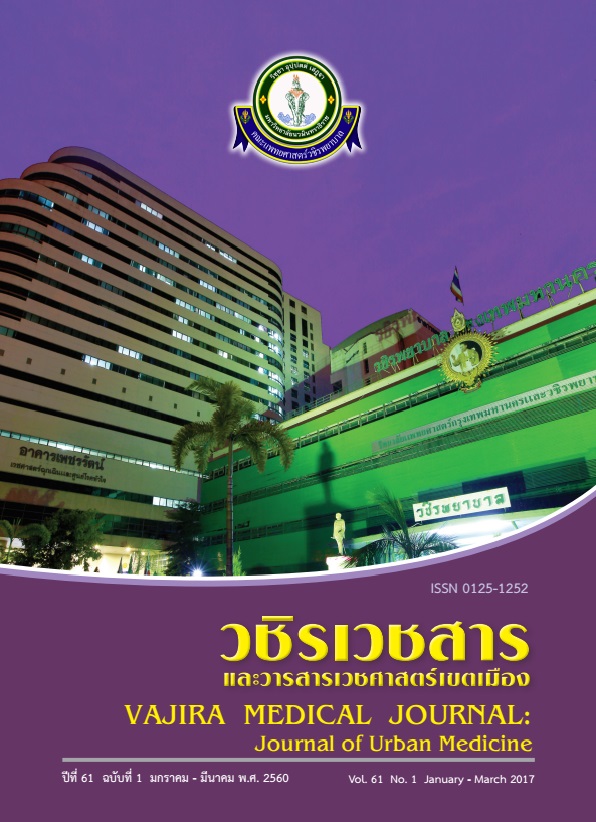Warning Symptoms, Risk Factors, and Functional Recovery in Stroke Patients.
Main Article Content
Abstract
Objective: To describe the relationship between stroke warning symptoms, risk factors and functional recovery in stroke patients.
Methods: In this cross-sectional study. The subjects, purposively sampled, were patients who were diagnosed with stroke and follow-up treatment at the outpatient departments of a tertiary hospital in Bangkok. Data were collected using 1) personal demographic questionnaire, 2) perception of stroke warning symptoms and risk factors questionnaires, and 3) functional recovery form. The data were analyzed using descriptive statistics and Spearman’s rank correlation.
Results: 139 patients were recruited. 44.6% were aware of stroke warning symptoms but only 11.5% identified all stroke warning symptoms correctly. Trouble speaking, unilateral paralysis and sudden weakness were the most commonly recognized stroke symptoms. 53.9% were aware of stroke risk factors but only 23% identified all risk factors of stroke correctly. Hypertension was the most commonly recognized risk factor. Functional recovery as assessed by Barthel ADL index was high (mean=15.31; SD=5.21) but was low (mean=6.15, SD=3.01) as assessed by instrumental activities of daily living (IADL). Age, clinical characteristics and sources of information were significantly associated with the perception of stroke warning symptoms. Education, time to arrival at hospital and sources of information were significantly associated with the perception of stroke risk factors. Neither perception of stroke warning symptoms nor risk factors were associated with functional recovery.
Conclusion: Most patients were not able to recognize important warning signs/symptoms and risk factors of stroke. Multi-faceted education programs to encourage patients access to acute care after stroke should be emphasized.
Downloads
Article Details
References
2. Public health statistic. [internet] 2014 [cited 2015 December 2] Available from: http://bps.moph.go.th/new_bps/sites/default/files/health_statistics 2557.pdf.
3. Rabadi MH, Rabadi FM, Edelstein L, Peterson M. Cognitively Impaired Stroke Patients Do Benefit From Admission to an Acute Rehabilitation Unit. Arch Phys Med Rehabil. 2008; 89(3):441-8.
4. Poungvarin N, Prayoonwiwat N, Senanarong V, Chaisevikul R, Danchaivijitr C, Nilanont Y. Siriraj acute stroke unit: the experience of 614 patients. Siriraj Hospital Gazette. 2002; 54(3):151-8.
5. Ferro JM, Biller J. Evidence-based Management of Stroke. Harley, UK: TFM Publishing Ltd; 2011.
6. Vanhook P. The domains of stroke recovery: a synopsis of the literature. J Neurosci Nurs. 2009; 41(1):6-17.
7. Lutz BJ, Young ME, Cox KJ, Martz C, Creasy KR. The Crisis of Stroke: Experiences of Patients and Their Family Caregivers. Top Stroke Rehabil. 2011; 18 (6):786-97.
8. National Institute of Neurological Disorders and Stroke (NINDS). Stroke rehabilitation information. [internet] 2009 [cited 2014 May 2] Available from: http://www.stroke.org.
9. Harwell TS, Blades LL, Oser CS, Dietrich DW, Okon NJ, Rodriguez DV, et al. Perceived risk for developing stroke among older adults. Prevent Med. 2005; 41(3–4):791-4.
10. Neau J-P, Ingrand P, Godeneche G. Awareness within the French population concerning stroke signs, symptoms, and risk factors. Clin Neurol Neurosurg. 2009; 111(8):659-64.
11. Kittiboonthawal P, Yingrengreung S, Srithanya S. Perceptions of stroke warning signs among risk patients. Nursing J Ministry Pub Health. 2014; 23(3):132-41.
12. Nualnetr N, Wannapong S, Khama S. Perception of stroke fast track among risk persons in community. Srinagarind Med J. 2015; 30(1):22-9.
13. National Institute of Neurological Disorders and Stroke (NINDS). Announces effort to promote stroke awareness in the hispanic community. [internet] 2010. [Cited 2014 May 2] Available from: http://www.ninds.nih.gov.
14. Clinical nursing practice guideline for stroke [Internet]. 2007. [cited 2014 May 18] Available from: http://thaineuronurse.com/file/cnpg/1.pdf.
15. National Stroke Foundation-Australia. Signs of stroke FAST. [internet] 2010. [cited 2014 May 22] Available from: http://strokefoundation.com.au.
16. Travis LH, Flemming KD, Brown RD, Jr., Meissner I, McClelland RL, Weigand SD. Awareness of stroke risk factors, symptoms, and treatment is poor in people at highest risk. J Stroke Cerebrovasc Dis. 2003; 12(5):221-7.
17. Mano H. Perceived stroke warning signs among hypertensive patients long hospital, Phrae Province. [thesis]. Chiang Mai: Chiang Mai University; 2010.
18. Rosner B. Fundamentals of biostatistics. 7th ed. Canada: Cengage Learning; 2011. 888p.
19. Letombe A, Cornille C, Delahaye H, Khaled A, Morice O, Tomaszewski A, et al. Early poststroke physical conditioning in hemiplegic patients: A preliminary study. Ann Phys Rehabil Med. 2010; 53 (10): 632-42.
20. Zeng Y, He G-P, Yi G-H, Huang Y-J, Zhang Q-H, He L-L. Knowledge of stroke warning signs and risk factors among patients with previous stroke or TIA in China. J Clin Nurs. 2012; 21 (19-20):2886-95.
21. Das K, Mondal GP, Dutta AK, Mukherjee B, Mukherjee BB. Awareness of warning symptoms and risk factors of stroke in the general population and in survivors stroke. J Clin Neurosci. 2007; 14 (1):12-6.
22. Hanchaiphiboolkul S, Poungvarin N, Nidhinandana S, Suwanwela NC, Puthkhao P, Towanabut S, et al. Prevalence of stroke and stroke risk factors in Thailand: Thai Epidemiologic Stroke (TES) Study. J Med Asso Thai. 2011; 94 (4):427-36.
23. Brenner DA, Zweifler RM, Gomez CR, Kissela BM, Levine D, Howard G, et al. Awareness, Treatment, and Control of Vascular Risk Factors Among Stroke Survivors. J Stroke Cerebrovasc Dis. 2010; 19 (4):311-20.
24. Zerwic J, Hwang SY, Tucco L. Interpretation of symptoms and delay in seeking treatment by patients who have had a stroke: exploratory study. Heart Lung. 2007; 36 (1):25-34.
25. Becker KJ, Fruin MS, Gooding TD, Tirschwell DL, Love PJ, Mankowski TM. Community-Based Education Improves Stroke Knowledge. Cerebrovasc Dis. 2001; 11 (1): 34-43.
26. Howard VJ, Lackland DT, Lichtman JH, McClure LA, Howard G, Wagner L, et al. Care Seeking after Stroke Symptoms. Ann Neurol. 2008; 63(4): 466-72.
27. Dobkin BH. Rehabilitation and recovery of the patient with stroke. 5th ed. USA: Elsevier; 2011.


